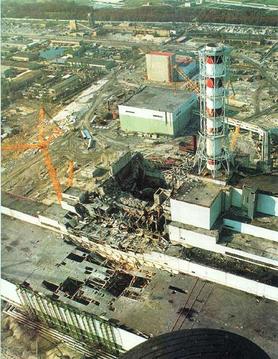Nuclear Reactors 324 - There May Have Been A Nuclear Fission Reaction At Chernobyl In 1986
In 1986 near the Ukrainian town of Pripyat in northeastern Ukraine at the Chernobyl nuclear power plant, there was a major nuclear accident. Safety systems had been turned off in order to carry out a test of emergency cooling systems. A number of such tests had been carried out in previous years and the systems failed to perform as expected. Apparently workers had configured the core improperly which contributed to the accident. After the test was started, the emergency cooling systems failed spectacularly.
Eyewitnesses say that there were two explosions. The first explosion was thought to be a steam explosion that hurled radioactive materials into the atmosphere. After the first explosion, there was a second explosion. The twenty-ton lid of the reactor was thrown a hundred feet into the air. A graphite fire broke out that lasted for nine days and injected more radioactive materials into the atmosphere. Radioactive materials fell over Europe as a result of the accident.
Four days after the accident, scientists took samples of soil at the town of Cherepovets north of Moscow, far from the primary dispersal track of the fallout from the accident. They found radioactive isotopes of xenon in the samples.
Over one hundred and sixty thousand residents of the surrounding area were evacuated and a large area around Chernobyl was declared a forbidden “Dead Zone” by the Soviet government. This exclusionary “Dead Zone” will have to exist for hundreds of years until the radioactivity cools off to safe levels although wildlife seems to be flourishing even with the radioactivity. Now some researchers examining radioisotopes from the accident have concluded that in addition to the steam explosion, there was a nuclear fission explosion as well.
Researchers from the Swedish Defense Research Agency, Swedish Meteorological and Hydrological Institute, and Stockholm University have published an article in the journal Nuclear Technology that claims that the xenon in the sample from Cherepovets could only have been caused by a fission reaction during the accident.
They believe that the first explosion reported by witnesses was a nuclear fission explosion, not a steam explosion. They say the second explosion which followed the first by about three seconds, was the steam explosion that resulted from water hitting the core and flashing to steam. The steam explosion ruptured the reactor vessel. A fission explosion would have thrown radioactive materials higher than a steam explosion which would explain how the isotopes of xenon got to Cherepovets. Examination of the pictures of the damage caused by the accident to the structure of the reactor indicate a higher-powered explosion than steam. In addition, a section of the floor plate of the reactor made of steel melted. A steam explosion could not have been hot enough to melt steel. Witnesses said that there was a blue flash above the reactor at the time of the first explosion which would be consistent with a fission explosion.
It is interesting that over thirty years have passed since the Chernobyl accident and we are still learning new things about what happened on that day in 1986.
Chernobyl:
